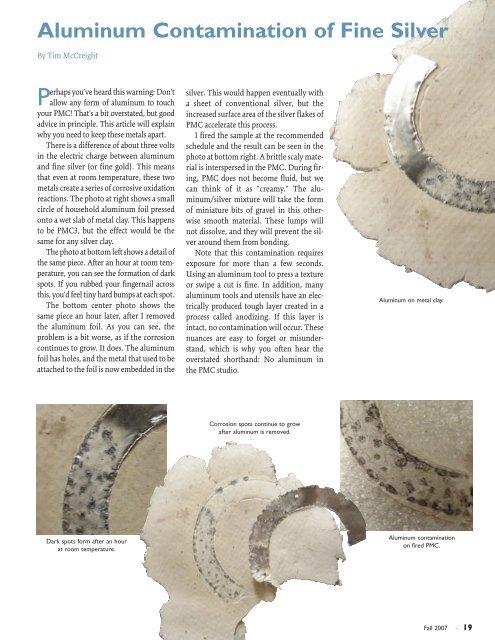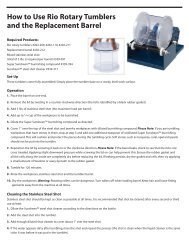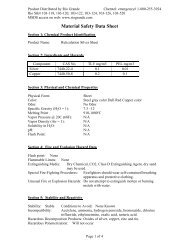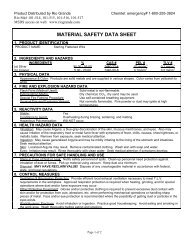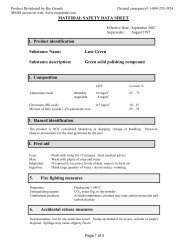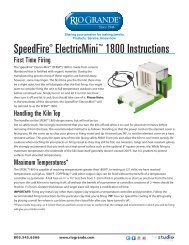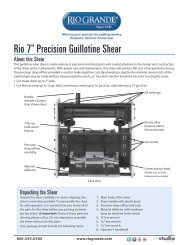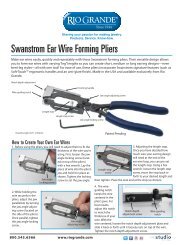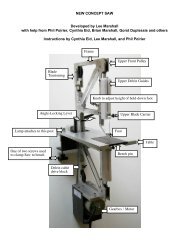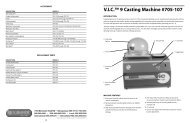Studio PMC - Rio Grande
Studio PMC - Rio Grande
Studio PMC - Rio Grande
- No tags were found...
Create successful ePaper yourself
Turn your PDF publications into a flip-book with our unique Google optimized e-Paper software.
Aluminum Contamination of Fine Silver<br />
By Tim McCreight<br />
Perhaps you've heard this warning: Don't<br />
allow any form of aluminum to touch<br />
your <strong>PMC</strong>! That's a bit overstated, but good<br />
advice in principle. This article will explain<br />
why you need to keep these metals apart.<br />
There is a difference of about three volts<br />
in the electric charge between aluminum<br />
and fine silver (or fine gold). This means<br />
that even at room temperature, these two<br />
metals create a series of corrosive oxidation<br />
reactions. The photo at right shows a small<br />
circle of household aluminum foil pressed<br />
onto a wet slab of metal clay. This happens<br />
to be <strong>PMC</strong>3, but the effect would be the<br />
same for any silver clay.<br />
The photo at bottom left shows a detail of<br />
the same piece. After an hour at room temperature,<br />
you can see the formation of dark<br />
spots. If you rubbed your fingernail across<br />
this, you'd feel tiny hard bumps at each spot.<br />
The bottom center photo shows the<br />
same piece an hour later, after I removed<br />
the aluminum foil. As you can see, the<br />
problem is a bit worse, as if the corrosion<br />
continues to grow. It does. The aluminum<br />
foil has holes, and the metal that used to be<br />
attached to the foil is now embedded in the<br />
silver. This would happen eventually with<br />
a sheet of conventional silver, but the<br />
increased surface area of the silver flakes of<br />
<strong>PMC</strong> accelerate this process.<br />
I fired the sample at the recommended<br />
schedule and the result can be seen in the<br />
photo at bottom right. A brittle scaly material<br />
is interspersed in the <strong>PMC</strong>. During firing,<br />
<strong>PMC</strong> does not become fluid, but we<br />
can think of it as "creamy." The aluminum/silver<br />
mixture will take the form<br />
of miniature bits of gravel in this otherwise<br />
smooth material. These lumps will<br />
not dissolve, and they will prevent the silver<br />
around them from bonding.<br />
Note that this contamination requires<br />
exposure for more than a few seconds.<br />
Using an aluminum tool to press a texture<br />
or swipe a cut is fine. In addition, many<br />
aluminum tools and utensils have an electrically<br />
produced tough layer created in a<br />
process called anodizing. If this layer is<br />
intact, no contamination will occur. These<br />
nuances are easy to forget or misunderstand,<br />
which is why you often hear the<br />
overstated shorthand: No aluminum in<br />
the <strong>PMC</strong> studio.<br />
Aluminum on metal clay.<br />
Corrosion spots continue to grow<br />
after aluminum is removed.<br />
Dark spots form after an hour<br />
at room temperature.<br />
Aluminum contamination<br />
on fired <strong>PMC</strong>.<br />
Fall 2007 · 19


